How is a Kumari Goddess chosen?
The selection procedure for Kumari is very confidential and done with many specifications. It is said that she must possess the 32 Lakshyana (32 perfections) or Kumari perfections in order to be chosen for further examinations. The 32 physical perfections include a chest like a lion, eyelashes like cows, a body like a banyan tree, thighs like a deer, and a voice as soft and clear as a duck.
Goddess Kumari is chosen by five senior Buddhist Bajracharya: the Chief Royal Priest, the Priest of Taleju, a royal astrologer, and the Priest of Taleju. Kumari the Living Goddess must meet a number of criteria before she is considered for acceptance, including the absence of visible scars and marks, the presence of uncut and blemish-free body skin, the absence of menstruation, and the presence of all of her teeth. Kumaris can't come from a family with an intercaste marriage, and they shouldn't have taken part in Ihi-Bel Biha, a Newar home ritual.
This special test is performed during the Kalratri (9 Black Nights) of Dashain, the most important festival. For the final selection of Kumari, she has to spend a night with 108 heads of buffaloes and goats that are sacrificed to goddess Kali. They are kept in a room lit by candles, along with a few masked men who make scary noises and watch to see if the girl is scared. She also has to search for the belongings of the ex-Kumari in the same room. If she passes this test, she will be known as the new Living Goddess Kumari in Nepal. If she fails, another girl is chosen to take the same test.
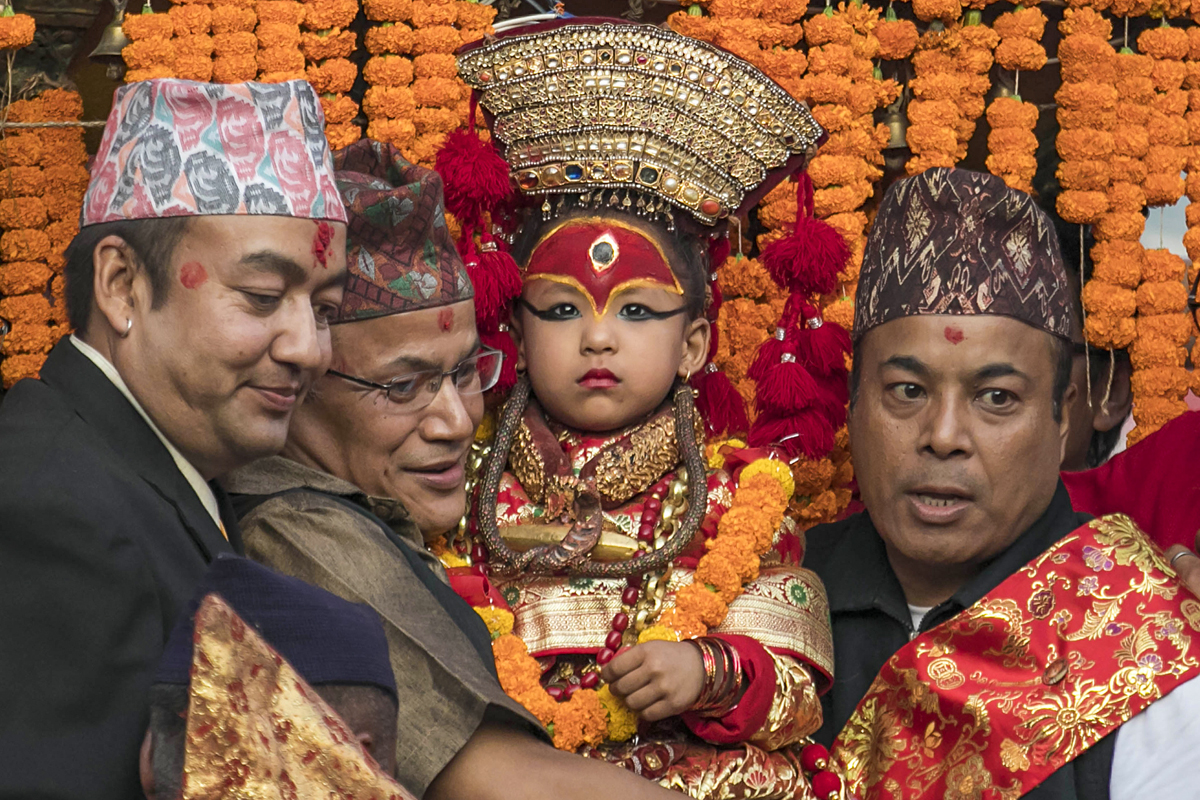
Shakti (power) of Kumari
In Nepal, the Hindu Buddhist community considers Kumari as the goddess of Shakti (power), as she is the living incarnation of the Taleju Bhawani and Durga. Devi is regarded as being above all others, as people believe it is the power of the goddess that brings everything into being and makes it live. There is nothing without the power of the goddess; that's why people worship Kumari, as they believe the power is in her pure and living form. Unlike the male gods, Kumari has a separate identity and set of attributes. The living goddess is one such manifestation and a particularly powerful one since she materializes in the human incarnation. On normal days, people worship in a simple manner. The audience room is on the second floor of the Kumari Ghar, with the golden throne, and the King worships her through the golden window overlooking the Durbar Square. All powerful pujas take place in the Kumari Ghar, whereas the special, deeper practices of Kumari the Living Goddess worship are kept secret from everyone, even the local Newars.
Life after being chosen as Kumari
After being chosen as a Kumari, she has to follow different rules and regulations, like having to be a serious-looking girl with very little body movement. She is not allowed to touch the ground except in the place she is worshiped, as she is considered the living incarnation of the goddess, and the land is also considered to be god. So, Kumari (as a goddess) is not allowed to touch another god. Kumari Devi is carried by the caretaker or in a palanquin.
Blood is very important to the Kumari because it is thought to hold the goddess Durga's creative energy, called Shakti. But, as Kumari Devi is half Hindu and half Buddhist, she is not allowed to see the sacrifice, and the animal's sacrifice should be carried out before she arrives at the goddess inside her. The main reasons behind this were pollution, and she couldn't even bleed herself because the blood could contaminate the shakti of the goddess inside her. All her blood has to remain inside her body; not even a drop should be spoiled. Although Kumari Devi is a child, she has all the potential of a woman.
There are almost 10 Kumaris in the present context. The recently selected Kumari is Trishna Shakya (the Royal Kumari), who is residing in the Kumari Ghar, Basantapur Durbar Square. She was chosen in 2017, while Unika Bajracharya, the Kumari of Patan and the second most important living goddess, was chosen as Kumari in 2014. It is said that Kumari Devi is most powerful during Indra Jatra and the ninth day of Dashain (Navami).
The Sublime Navami and Dashami
On the first day of Dashain (Ghatasthapana), a sacred clay Kalash, or vessel, is placed in the temples throughout the valley and in the prayer room of every house. They put barley seeds in the seed, which summoned the goddess's spirit. Every morning, the Kalash is prayed over, sprinkled with pure water, and shielding it from the light. As the barley seed grows, the physical presence of Durga intensifies.
On the 10th day, the shoots would be five to six inches tall, and the sacred yellow jamara would be cut and distributed as the blessing of the goddess Durga.
Dashain is an important time for Kumari and the whole country. On the 9th day, Navami, Kumari is said to be in her most powerful form and becomes the Goddess Durga’s great warrior against the buffalo demon (Mahishasura). There would be sacrifices all over Nepal to mark the victory of the goddess Durga and the restoration of the world. The main reason to sacrifice the 108 buffaloes and goats, especially all black, was to represent Mahishasura himself. Proper worship of the goddess during Nawami was her moment of supreme power and secured her blessing for the coming year.
Every weapon honored with blood on the day of Navami is believed to be charged with the power of the goddess Durga. Worshiping the goddess Durga is said to purge the world of bad intentions and get rid of evil influences in the future. Different animals are sacrificed which represents a different vice, buffalo as anger, goats as lust, sheep as stupidity, ducks as apathy, and chicken as fearfulness.
The Third Eye of Kumari
People around the world have a spiritual and holistic belief in the "fire eye" or "third eye," located in the sacred spots on the forehead. It is said that a fire-eye can make someone happy or turn someone into a pile of burning ashes. Kumari wears the “third eye," the dristi (a golden eye with a black pupil), only during Dashain or Indra Jatra, when she is regarded as being as powerful as she can get. It is said to open the channels of communication between Kumari Devi and the goddess. It is said to have a powerful connection with the goddess if they communicate through the third eye.
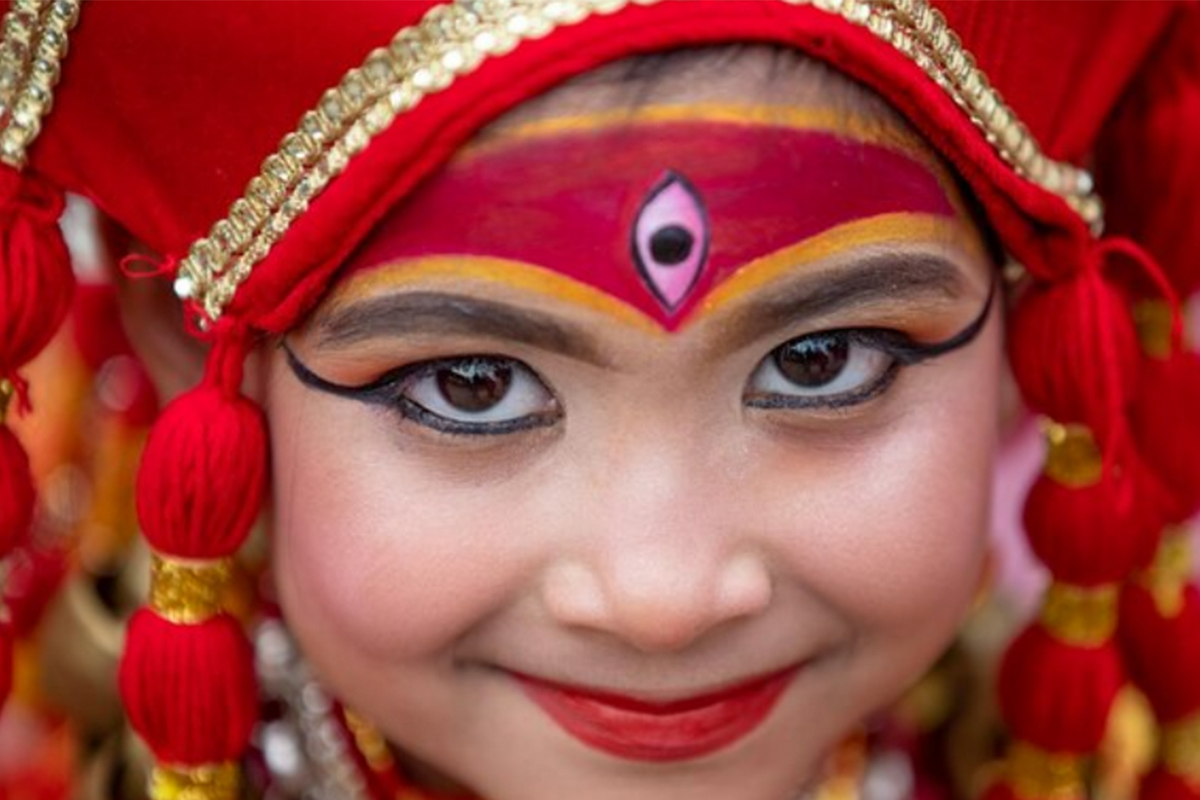
Taleju Temple (Kumari Ghar)
There are several Kumaris in Nepal, though the Royal Kumari lives in Kathmandu in a special place called Kumari Ghar. The last king, Jay Prakash Malla, built the residence for the Living Goddess across Durbar Square. It is only opened on the 9th day of Dashain (Navami). Only one priest was allowed in the Kumari Ghar, and it was strictly prohibited for foreigners to enter the Kumari Ghar. The Kumari Ghar, Temple of the Living Goddess Kathmandu is an example of the magnificent architecture of Nepal, with its intricate wood carvings of the gods and various symbols.
You can visit the Temple of the Living Goddess Kathmandu at Basantapur Durbar Square, where the Kumari lives, and get a glimpse of the living goddess. If you visit in late August or September, you will undoubtedly be a part of Indra Jatra, Kathmandu's largest and most lively festival, in which the Kumari is paraded through the city in her golden palanquin.
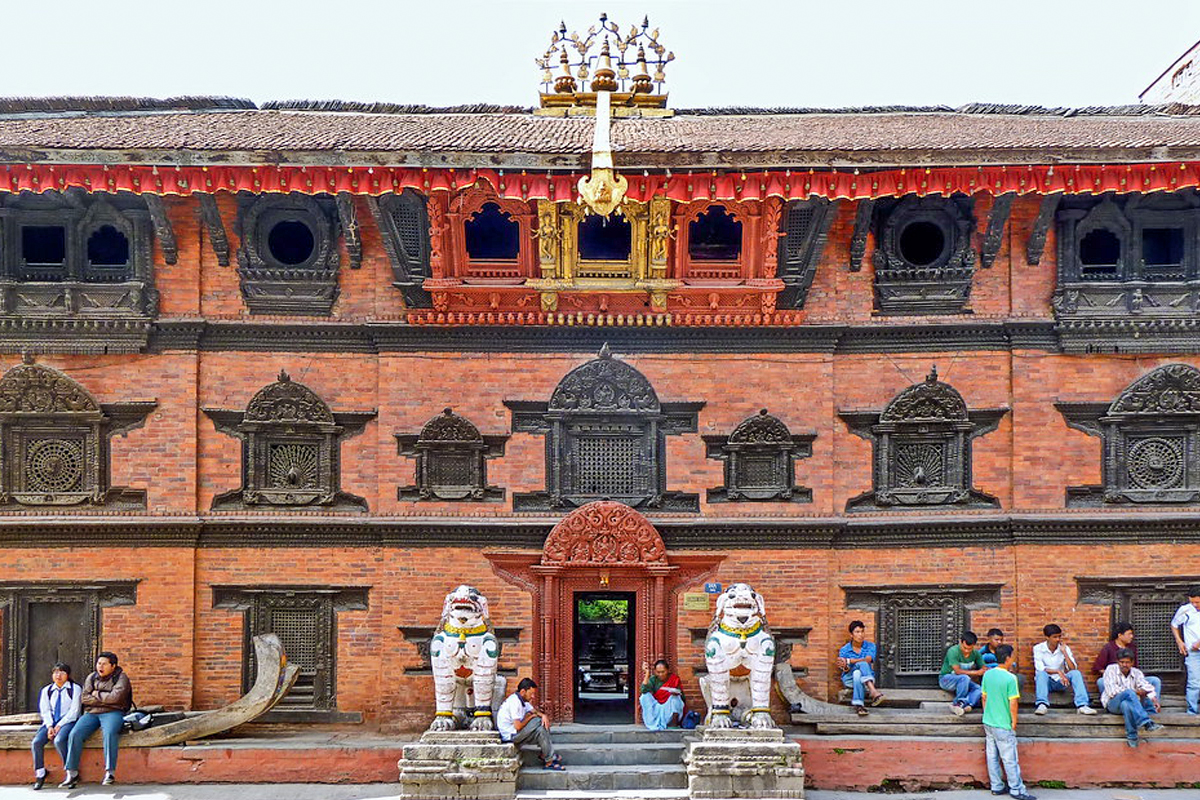
Life-deciding gestures of Kumari
Kumari is supposed to be serious-looking while a goddess but can smile and live a normal life when not being worshiped. There are different signs Kumari shows when she makes predictions about you:
- Crying/Louder Laugh: Severe Illness or death
- Picking at food offerings: financial losses
- Hand Clapping: Reason to fear the king
- Weeping or rubbing eyes: imminent death or last days
- Trembling: Imprisonment
The De-thronement of Kumari
Kumari Devi is known as the human symbol of power and protection for the country. She is considered the sole representation of pureness to the Hindus and Buddhist communities. Kumari is not even allowed to bleed through any physical or biological means; if she does, she is no longer considered the living goddess. It is said that the goddess relinquishes the body of Kumari after she has bled. It is said that the blood loss from the body of Kumari spoils the purity of the goddess inside her, and she loses all the divine power of the living goddess.
Ex-Kumari
There are around 12 Kumaris in Nepal, including the Living Goddess of Kathmandu, Patan, Sankhu, Bhaktapur, and others. In the past, the Kumaris were not fully educated due to different superstitious beliefs. They were also not allowed to get married as it was a myth that the groom would have a very short life if he married the ex-Kumari. But the myth has been broken, and the ex-kumaris can marry as long as they want to get married.
In the present context, the ex-kumaris are fully educated inside the Kumari Ghar when they are not dressed up as Kumaris and have been given full rights to play inside the Kumari Ghar. After de-thronement, many ex-kumaris have been studying or working as per their interests, and they are given the same respect as normal people after de-thronement.
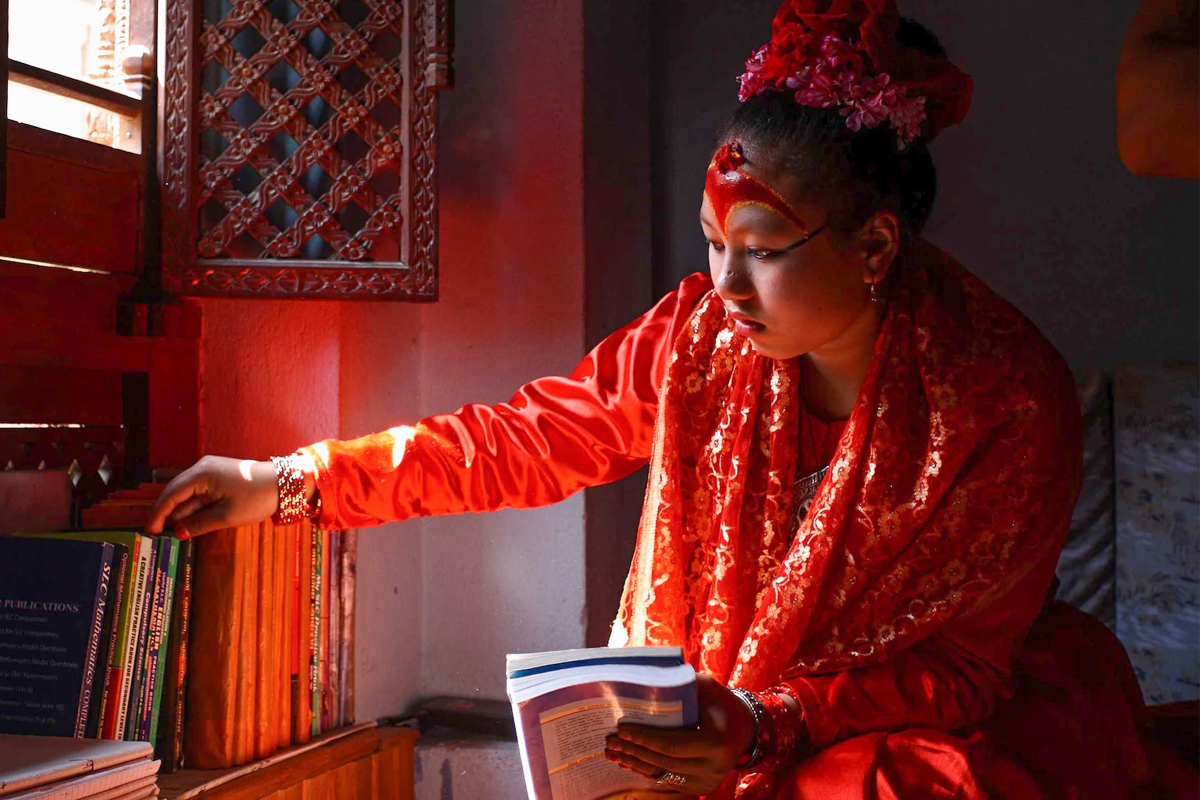
Life after Dethronment
The Life of a Kumari Goddess takes a turn after the de-thronment. The majority of the Kumaris have described the change from "divine goddess" to "normal girl." Though things are challenging at first, they eventually get back to normal. As a result, it's clear that Kumari's existence isn't as harsh as commonly believed.
More people come to see the chariot of Kumari the living goddess of Nepal, at the festival of Indra Jatra than any of the other male gods. Since Nepal has traditionally been a patriarchal nation, the sight of strong dignitaries and monarchs bowing to a little girl is striking and intriguing.
The fact that people of different faiths can come together to worship a young girl is pretty indicative of a great deal of religious diversity in Nepal. Millions of people all around the world dedicate time and energy to documenting and researching the past. Traditions around Kumari, the Living Goddess, have broader cultural and historical significance. But it reflects Nepalese culture and Nepalese people in the world. In my opinion, locals' faith has been safeguarded through the maintenance of this culture. This made people aware of the respect given to feminine beauty. Also, spread the word about Nepal's rich cultural heritage to the rest of the world.
It is said that getting a glimpse of the goddess would bring luck and success. Therefore, the majority of people, both Nepalese and foreigners, wait in Kumari Ghar's courtyard to catch a glimpse of Kumari through the window. Although Kumari is a child, she has all the potential of a woman. The fact that she was not menstruating or losing any blood by any means was a sign of the creative power within her body. Due to this reason, it is said that people visit Kumari especially when they have any blood-related problems or disorders like hemorrhaging (bleeding from a ruptured blood vessel), menstrual problems, or when they are coughing up blood. People also visit her when they have miscarriages.
Kumari Jatra
Kumari Jatra is an exciting festival celebrated annually during the month of September. It is part of the celebration during the Indra Jatra, the largest public festival celebrated by both Hindu and Buddhist communities in the Kathmandu Valley. Indra Jatra is considered one of the most popular and exciting festivals of the Newar community.
On this day, a Living Goddess Kumari is all jeweled up with a full face of makeup, a red dress, red lips, and her special third eye. She is taken out of the Kumari Ghar in her golden palanquin, with a huge crowd of people following the palanquin to seek her blessings and witness the procession of the goddess. The chariot of Kumari Devi is followed by two other chariots, those of Ganesh and Bhairav. The Indra Jatra is celebrated for eight days with masked dancers called Lakhey. The Lakheys are taken to almost every corner every evening during those eight days, accompanied by loud drums, and they perform special dances on the streets called the Lakhey Dance.
On the last day of Kumari Jatra, the president (a king in the past) traditionally presented himself or herself before the Kumari to receive a red mark (tika) on their forehead, an annual ritual legitimating their right to rule. This tradition was started by the late King Jayaprakash Malla in the 18th century.
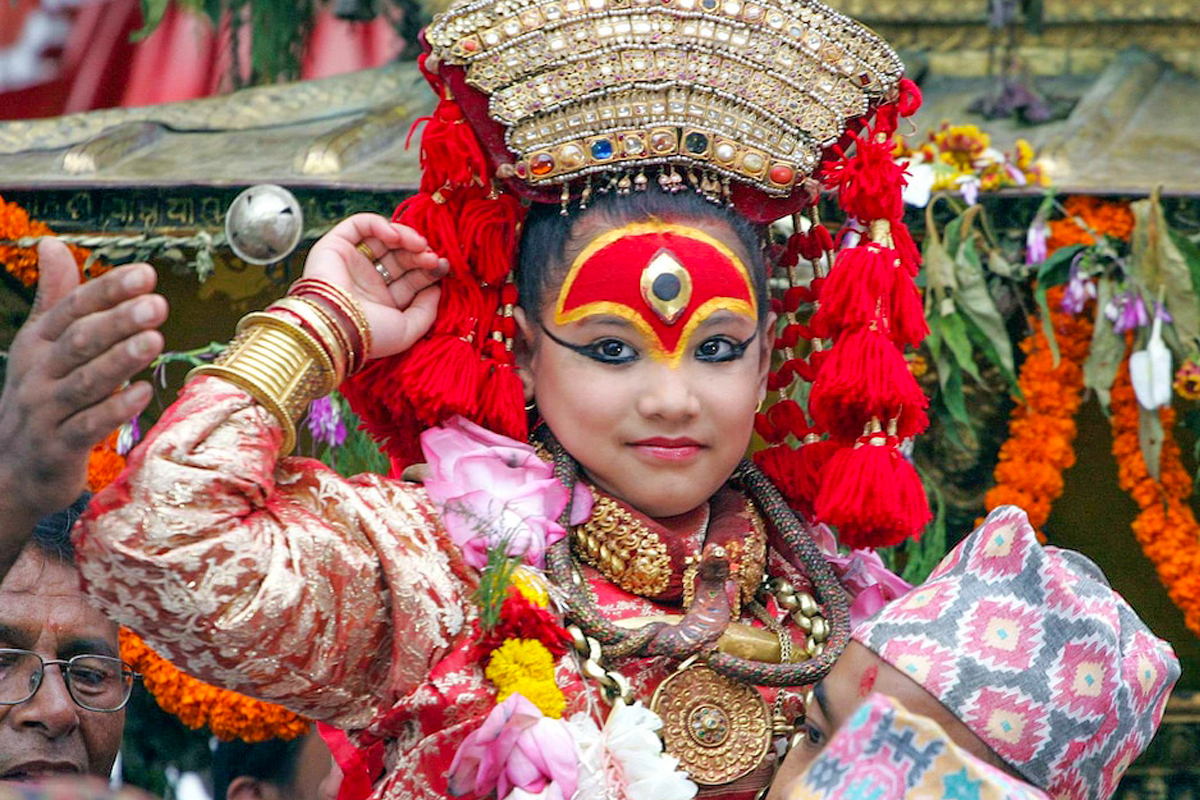
Frequently asked questions about The Living Goddess- Kumari
Who is the current Royal Kumari of Nepal?
Trishna Shakya is the current royal Kumari of Nepal. She was chosen after Matina Shakya on September 27, 2017. She was three years old when she was declared the Living Goddess.
Can you marry a Kumari?
For instance, it is commonly believed that being a Kumari can prohibit a woman from marriage because it is a common belief that former Kumaris' spouses pass away at a young age.
In the past, the Kumaris were not fully educated due to different superstitious beliefs. They were also not allowed to get married as it was a myth that the groom would have a very short life if he married the ex-kumari. But, the myth has been broken, and the ex-kumaris can marry as long as they wish to get married.
What happens to Kumari after she hits puberty?
As soon as the Kumari Devi hits puberty or gets bled through any means, she is dethroned, as the blood bled from her body pollutes the Shakti of the goddess Durga inside her, and another prepubescent girl is chosen as the next Kumari.
Who was the first Royal Kumari of Nepal?
Preeti Shakya was the First Royal Kumari of Nepal. She was three years old when she was declared the Royal Kumari in 2001. She was worshiped for eight years until she returned to her normal suburban life.
At what age is Kumari chosen?
A 2-5-year-old prepubescent girl from the Shakya ( Newar - Buddhist) Clan is chosen, and she is carefully picked for her beauty in order to represent a manifestation of the goddess Kali. At a very young age, they are removed from their family to fulfill the role of living goddesses.
Who is the oldest Kumari in Nepal?
Miss Dhana Kumari Bajracharya is the oldest Kumari in Nepal and is from Patan. She was chosen Kumari in 1954 AD when she was 2 years old and is still following the cloistered lifestyle as she never got her menstruation which led her to be the 71-year-old Kumari.
Who is known as the Living Goddess of Nepal?
The only Living Goddess “Kumari” lives in Nepal, and is worshiped by both Hindu and Buddhist communities of Nepal. The meaning of Kumari is Virgin where a young prepubescent girl is said to be the living incarnation of the goddess Durga and Taleju Bhawani.
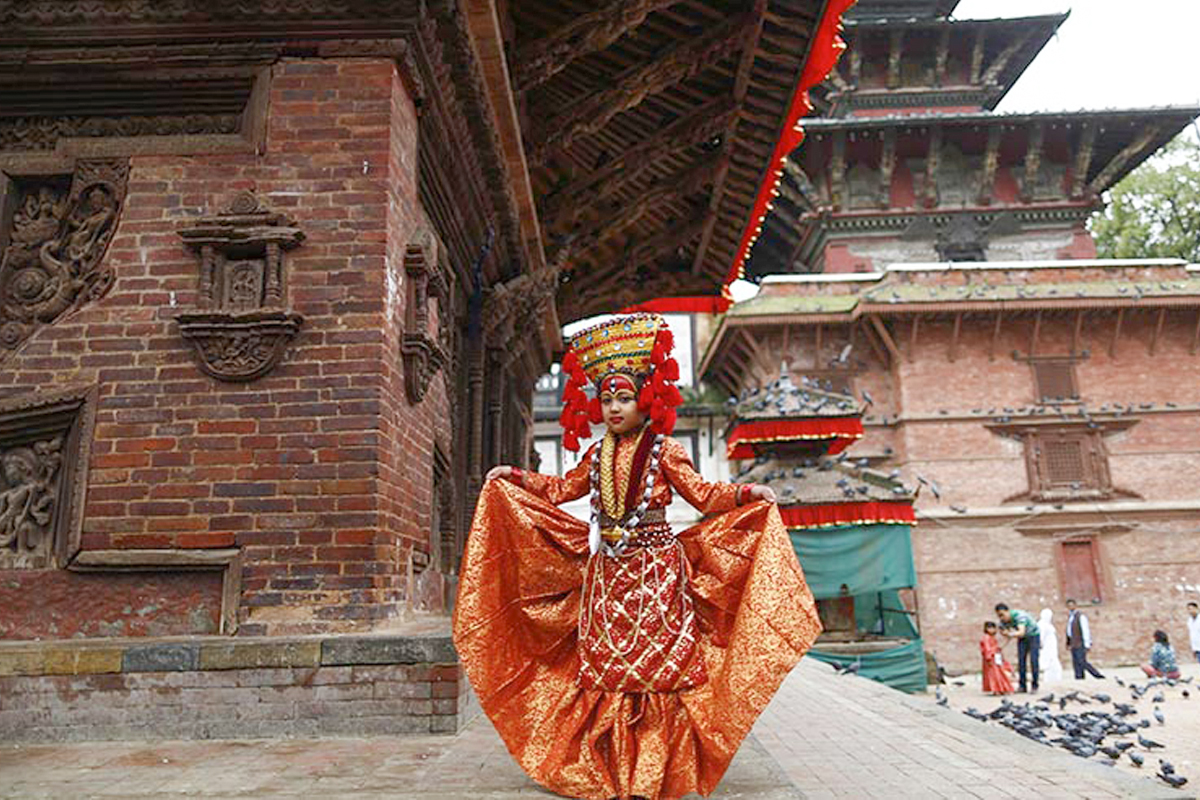
What are the 32 perfections of Goddess Kumari?
The selection of Kumari is very confidential and strict. It is said that she must possess all the physical 32 perfections in order to be eligible for the living goddess, Kumari. Followings are the physical perfections she must possess then only she is eligible for further tests.
- Virgin
- Body like a Banyan Tree (Nyagrodha)
- Eyelashes like Cow
- A broad forehead
- Neck like a conch shell
- No blemishes, moles, or Birthmarks
- Chest like a lion
- Body formed like a Saptacchata Leaf
- Voice soft and clear as of a duck
- Same horoscope as of the King
- Round shoulders
- No bad body odor
- Perfectly shaped teeth
- Sign of Serenity and Fearlessness
- A well-formed heel
- Black Straight Hair and Dark Eyes
- Delicate and Soft hands and feet
- Thighs like those of a deer
- Small and moist tongue
- Sexual Organs are small and well-recessed
Kumari is chosen by five senior Buddhist Bajracharya: the Chief Royal Priest, the Priest of Taleju, a royal astrologer, and the Priest of Taleju.
Is Kumari Pratha violating child rights?
The current debate and pressure from human rights and children's rights advocates in Nepal on the Kumari system have slightly softened the strict rules that regulate Kathmandu's Kumaris. Kumaris lacked proper education and understanding of their surroundings and social life. This complicated the transition from a living goddess to a common mortal after dethronement.
Today, Kumari in the Kumari Ghar receives education and a private tutor. Even the Internet, books, and magazines are available for use. The Kumari take part in national exams while being observed inside the palace. After losing the title of living goddess, Kumari Goddess takes a step towards a better future.








